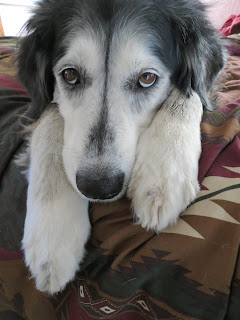Sitting outdoors with sketchpad on my knees, looking up at the mountains, following their lines and shadings with my eyes, and trying to catch their shapes with a soft pencil, I am perfectly content. To fill a page not with words but other, different kinds of marks -- poor copies of the world before me and done for no other purpose than my own pleasure, but somehow it seems a completely worthwhile pursuit. A pursuit in stillness, for the most part, because unlike a camera, which pressures one to capture a fleeting moment in an instant click! my pencil lets me luxuriate in a slowly filling pool of time. Filling? Or emptying? Except for the constantly changing shadows of morning sunlight on the mountains, I would not be conscious of time’s passing at all, but those shadows do shift position, and when at last I close the sketchpad and carry pencils and book into the cabin, it occurs to me for the first time why so many of us turn to drawing, to watercolor, to whatever medium calls most clearly to us as individuals, in our later years. I think it is the general form of the more specific hunger I feel here in the high desert — the hunger for more.
“Always at my back I hear/time’s winged chariot drawing near….”
Here in my peaceful ghost town, with few demands on my time, I have had three months of precious freedom, and as this period draws to a close, I seek to prolong each hour. I attempt to be more completely in each moment — and also to unite my consciousness with the timeless presence of the mountains that have been a constant for so many days — by recording with pencil the scene before my eyes. In future weeks and months and years, when I am many miles distant, these simple, rough, quick amateur sketches will transport me back to mornings in the Arizona sun, and I will feel again its warmth on my arm, hear the mockingbird’s song falling on my ear and the distant lowing of a cow on the range. This will be my more, after my season here has expired.
Awareness, though, has been part of my ordinary being-in-the-world for as long as I can remember — hunger for looking, seeing, touching, hearing, and breathing in the aromas of life -- so it isn’t that I am aware of my surroundings only when away from home. When I think of the apple tree in my parents’ backyard, a tree gone now for many years (as I too have been gone from that house), the perspective in my memory is not from the ground but from high in the branches. Springtime blossoms, first hard little fruits, later ripening apples sometimes falling to the ground and startling me from my reveries — all these I experienced and remember from a quiet, leafy perch. And soon I will be back in northern Michigan, walking a dirt road with my dog high above Lake Michigan and noting every shift of breeze, every bird or insect song, every track and trail left on the dusty road by nighttime or early morning travelers — geese, deer, mice, snails. Noticing the world is something I take to be a joyful, everyday duty, because what is the gift of life if we do not take constant notice of it? I take noticing to be part of the practice of gratitude.
And yet there were all those years when work imprisoned me, or so it felt, in a series of offices, and I know that many people spend a lifetime so, because making a living is a necessity for most of us, and despite popular self-help books, “following one’s bliss” is rarely sufficient. To gain money, therefore, we pay with our time. Hence my sudden insight that in retirement so many people seek more than they have had up to that point. For many people, their retirement years might be the first time they allow themselves off the treadmill to look around and see the world. If it is intoxicating to me nearly every morning, how much more extraordinary would it be if I had never had such mornings in my life before?
The second part of my post-drawing morning epiphany about aging was that men and women who take up “art” late in life (and I include myself here) are seeking to extend not just one season’s happiness but life itself. As with the feeling that a sabbatical or vacation or time of travel is coming to a close, so as we age we feel our lives nearing the end. Most of us are not looking to fulfill a lifelong vocation denied for decades: certainly I do not see myself as an “artist,” even as aspiring one. Neither do I feel much need to “express myself” with my drawing. It isn’t myself I seek but the world. What is important to me, and I suspect for many others, is to slow down the clock, to invite the natural world fully into consciousness, and to dwell in and memorialize precious moments before our time for being here is over.
Does this make sense to anyone else? How do you satisfy your hunger for more? Or do you already have more than enough? I know we are all different....


























































